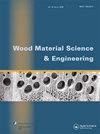Impact of visible knots on relative visual attractiveness of furniture fronts made of pine wood (Pinus sylvestris L.)
IF 2.1
3区 农林科学
Q1 MATERIALS SCIENCE, PAPER & WOOD
引用次数: 0
Abstract
ABSTRACT The main goal of this paper was to check if either the number or the composition (the arrangement or placement) of knots visible on the furniture fronts could be effective predictors of their relative visual attractiveness. Five different groups of human experts (73 people total) filled out a special online questionnaire, which contained 99 furniture front photos. The experts were asked to rate the relative attractiveness of the fronts using the 5-point Likert scale. It was found that an increase in the number of knots in the range of 0–4 significantly reduced the relative attractiveness of the front, but a further increase (from 4 to 8) made no statistically significant difference. Furthermore, the opinions of all expert groups turned out to be very similar, regardless of their professionalism in the field of interior or furniture design. No other (than the number of knots) predictors of the attractiveness of the fronts (such as the arrangement or placement of visual knots) could be found. The effectiveness of the number of knots as the only predictor of the visual attractiveness of cabinet doors (made of pine wood) was 61% or 87%, depending on the form of classification.可见结对松木家具正面相对视觉吸引力的影响(Pinus sylvestris L.)
摘要本文的主要目的是检查家具正面可见结的数量或组成(排列或放置)是否可以有效预测其相对视觉吸引力。五组不同的人类专家(共73人)填写了一份特殊的在线问卷,其中包含99张家具正面照片。专家们被要求使用5分的Likert量表对战线的相对吸引力进行评分。研究发现,结数在0–4范围内的增加显著降低了正面的相对吸引力,但进一步增加(从4增加到8)没有统计学上的显著差异。此外,所有专家组的意见都非常相似,无论他们在室内或家具设计领域的专业程度如何。没有其他(除了结的数量)预测正面吸引力的因素(例如视觉结的排列或位置)。根据分类的形式,结数作为橱柜门(松木制成)视觉吸引力的唯一预测指标的有效性为61%或87%。
本文章由计算机程序翻译,如有差异,请以英文原文为准。
求助全文
约1分钟内获得全文
求助全文
来源期刊

Wood Material Science & Engineering
Materials Science-General Materials Science
CiteScore
3.90
自引率
13.60%
发文量
131
审稿时长
79 days
期刊介绍:
Wood Material Science and Engineering is a multidisciplinary and international journal with the aim to serve at the forefront of the wood science and technology field. The journal publishes original articles on basic and applied research dealing with:
-Wood material science with emphasis on: water-wood relations, wood durability, wood modification, wood mechanics, wood composites, engineered wood products, energy conversion and eco-efficient wood based products.
-Wood engineering, i.e. the application of the wood material science to designing, processing and manufacturing of forest products and the use of machines and processes for these products. Products of concern are biofuels, sawn wood and further refined products such as structural elements, interior fittings and furnishings. In this aspect the link between the nature of the wood material and the properties of the final wood products in-service and its impact on the environment is of outmost importance.
High quality review papers may also be accepted but the topic should be discussed with the editor before submission.
 求助内容:
求助内容: 应助结果提醒方式:
应助结果提醒方式:


